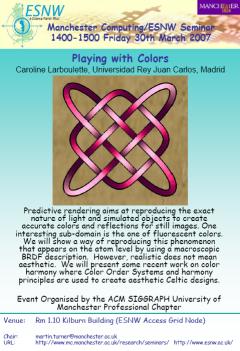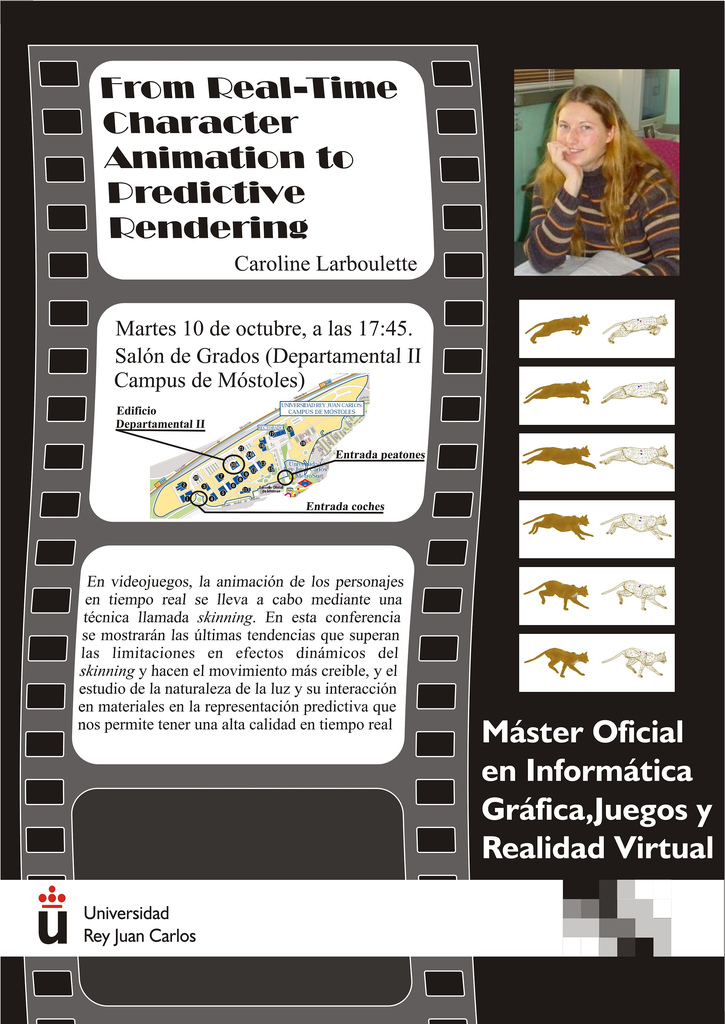Invited Talks of Caroline Larboulette
|
|
"Animating Virtual Characters and their Environment", Université
de Bretagne Sud, Vannes, 25 Nov 2011.
|
|
|
"Character Animation: from Modeling to Rendering", Ecole polytechnique de l'université de Nantes, 2 Apr 2010.
Les personnages virtuels sont de plus en plus présents dans nos vies: à la
télévision, au cinéma, dans les jeux vidéos, au musée, pour ne citer que
quelques exemples. Afin d'améliorer leurs animations, il est nécessaire de
développer des algorithmes à la fois plus précis et plus
performants. Malheureusement, une animation plus réaliste ne sera pas forcément
percue comme telle par les utilisateurs, surtout lorsqu'il s'agit d'humanoides
("uncanny valley"). Il est donc important de prendre en compte la perception
humaine lors de la création de nouvelles techniques.
Par ailleurs, l'animation
ne se fait pas indépendamment des étapes de modélisation puis de rendu qui
conditionnent le choix du type de représentation utilisé, la finesse des
algorithmes de déformations ainsi que leur type (géométriques ou basés sur la
physique). Dans cette présentation, nous aborderons les trois étapes du pipeline
d'animation appliquées aux personnages: modélisation, déformation et rendu. Nous
verrons aussi comment évaluer ces algorithmes avec des mesures perceptuelles et
améliorer les résultats obtenus par des considérations esthétiques.
|
|
|
"Real-Time 3D Character Animation", Trinity College Dublin, 29 Aug 2008.
|

|
"Playing with Colors", ACM SIGGRAPH Professional chapter, University of Manchester, 30 Mar 2007.
Predictive rendering aims at reproducing the exact nature of light and simulated
objects to create accurate colors and reflections for still images. One
interesting sub-domain is the one of fluorescent colors. We will show a way of
reproducing this phenomenon that appears on the atom level by using a
macroscopic BRDF description. However, realistic does not mean aesthetic. We
will present some recent work on color harmony where Color Order Systems and
harmony principles are used to create aesthetic Celtic designs.
|

|
"From Real-Time Character Animation to Predictive Rendering", Master de Informatica Grafica, Juegos y Realidad Virtual, Universidad Rey Juan Carlos, 10 Oct 2006.
In video games, real-time character animation is performed by a skeleton
subspace deformation technique also called skinning. Although it enables one to
simulate quite accurate kinematic deformations of the skin, muscles and fatty
tissues, it remains impossible to create all sorts of dynamic effects, of
primary importance to make a movement believable. We propose two different
techniques to enhance an existing animation. The first one addresses the problem
of dynamics of muscles and fatty tissues in sharp movements while the second
method provides a tool to model dynamic wrinkles of skin or clothes.
On the
other hand, predictive rendering aims at reproducing the exact nature of light
and simulated objects to create accurate colors and reflections for still
images. One interesting sub-domain is the one of fluorescent colors.
We will
show a way of reproducing this phenomenon that appears on the atom level by
using a macroscopic BRDF description. We will also discuss how one could
possibly include those colors in classical Color Order Systems like the Munsell
Book of Color or the Coloroid system. |
|
|
"Real-Time Processing of the Deformations of the Skin and Sub-cutaneous
Tissues for Character Animation", Vienna University of Technology, 29
Oct 2004.
|
|